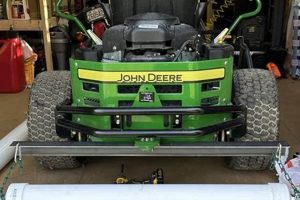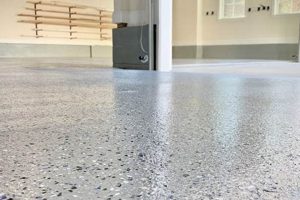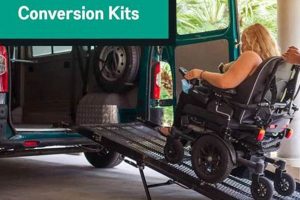A collection of components designed for users to assemble their own electric-powered skateboard. This typically includes a motor, battery, electronic speed controller (ESC), remote control, wheels, trucks, deck, and necessary hardware. The user is responsible for the final assembly and configuration to create a functional electric skateboard.
The appeal stems from the opportunity to customize performance characteristics, learn about electric vehicle technology, and potentially save money compared to purchasing a pre-built electric skateboard. These kits also allow for personalized design choices and the ability to repair or upgrade individual components more easily. The concept has evolved alongside advancements in battery technology and brushless motors, making electric skateboarding more accessible to hobbyists and DIY enthusiasts.
The subsequent sections will delve into the specific considerations involved in selecting components, the assembly process, safety precautions, and the potential for performance optimization within these build-it-yourself electric skateboard endeavors.
Essential Considerations for Electric Skateboard Construction
Successful assembly necessitates careful planning and execution. Prioritizing safety and adhering to best practices will contribute to a reliable and enjoyable riding experience.
Tip 1: Component Compatibility: Verify that all components (motor, ESC, battery) are compatible in terms of voltage, amperage, and communication protocols. Mismatched components can lead to system failure or potential hazards.
Tip 2: Battery Selection and Safety: Select a battery pack with appropriate capacity and discharge rate for the intended use. Adhere strictly to manufacturer guidelines for charging, storage, and handling. Improper handling of lithium-ion batteries can result in fire or explosion.
Tip 3: Motor Mounting and Alignment: Ensure the motor is securely mounted to the trucks and properly aligned with the wheel pulley. Misalignment can cause excessive wear and reduced efficiency.
Tip 4: Electronic Speed Controller (ESC) Programming: Familiarize oneself with the ESC programming parameters to optimize performance characteristics such as acceleration, braking, and top speed. Incorrect settings can compromise safety or damage the motor.
Tip 5: Secure Wiring and Connections: All wiring connections must be properly soldered or crimped and insulated to prevent short circuits. Secure wires to the deck to avoid chafing or entanglement with moving parts.
Tip 6: Thorough Testing: Before riding, conduct thorough testing in a controlled environment. Verify the functionality of the brakes, throttle, and remote control. Listen for unusual noises or vibrations that may indicate a problem.
Tip 7: Safety Gear: Always wear appropriate safety gear, including a helmet, knee pads, and elbow pads, when riding an electric skateboard. Prioritize safety and adhere to local regulations regarding electric skateboard use.
By addressing component selection, safety measures, and proper assembly techniques, one can significantly enhance the reliability and safety of the resulting electric skateboard.
The following sections will provide a detailed examination of component upgrades and performance optimization strategies.
1. Component Compatibility
In the realm of electric skateboard construction, “Component Compatibility” is paramount. It addresses the interconnectedness and harmonious operation of various electronic and mechanical parts. Incompatibility leads to diminished performance, system failure, or hazardous situations. Therefore, a rigorous understanding of specifications, tolerances, and operational parameters is necessary for a successful build.
- Voltage and Current Matching
The electric motor, ESC (Electronic Speed Controller), and battery pack must operate within compatible voltage and current ranges. For example, a 36V motor connected to a 48V battery pack may experience premature failure. The ESC must be rated to handle the motor’s maximum current draw to prevent overheating and damage.
- Motor and ESC Communication Protocols
The ESC communicates with the motor to control its speed and direction. Different motors and ESCs may utilize varying communication protocols, such as PWM (Pulse Width Modulation) or FOC (Field-Oriented Control). Selecting incompatible components can result in a lack of motor control or erratic behavior.
- Mechanical Compatibility of Drivetrain Components
The motor mount, wheel pulley, and belt must be mechanically compatible. The motor mount must securely attach the motor to the skateboard trucks. The wheel pulley must be appropriately sized for the wheel diameter and mate correctly with the motor pulley and belt. Misalignment or incorrect sizing can lead to belt slippage or premature wear.
- Battery Management System (BMS) Compatibility
The BMS is crucial for safeguarding lithium-ion batteries by regulating charging and discharging. A compatible BMS ensures that the battery pack operates within safe voltage and current limits, preventing overcharging, over-discharging, and overheating, which could result in fire or explosion.
The implications of incompatible components in a “diy e skateboard kit” context extend beyond mere operational challenges. They directly affect the rider’s safety and the longevity of the entire system. Therefore, thorough research and adherence to manufacturer specifications are crucial steps in ensuring a reliable and safe electric skateboard build. Ignoring these critical factors can lead to costly repairs or, more seriously, dangerous accidents.
2. Battery Specifications
Battery specifications are a cornerstone of any electric skateboard project. They dictate the vehicle’s range, power output, and overall performance. Neglecting these specifications when assembling an electric skateboard can result in a system that is either underpowered, has limited range, or is potentially unsafe.
- Voltage (V)
Voltage determines the rotational speed of the electric motor. Selecting a battery with an incorrect voltage for the motor can result in either insufficient power (undervoltage) or damage to the motor and ESC (overvoltage). Electric skateboards typically use battery packs ranging from 24V to 48V, depending on the desired performance characteristics. For example, a 36V system is a common choice, providing a balance between power and efficiency.
- Capacity (Ah or Wh)
Capacity, measured in Ampere-hours (Ah) or Watt-hours (Wh), directly correlates with the range of the electric skateboard. A higher capacity battery will allow the skateboard to travel further on a single charge. A 10Ah battery,
for instance, will generally provide a longer range than a 5Ah battery, assuming all other factors remain constant. This choice requires careful consideration of the intended use case longer commutes necessitate higher capacity. - Discharge Rate (C-Rating)
The discharge rate, expressed as a C-rating, indicates the maximum current that the battery can safely deliver continuously. An inadequate C-rating can lead to voltage sag under heavy load, reduced performance, and potential damage to the battery. A battery with a 10C rating, for example, can safely discharge at a rate equal to 10 times its capacity. If the capacity is 5Ah, the maximum continuous discharge current would be 50A.
- Battery Chemistry and Safety
Lithium-ion batteries are the predominant choice for electric skateboards due to their high energy density and relatively light weight. However, different lithium-ion chemistries exist, each with its own safety characteristics. Lithium Polymer (LiPo) batteries, while offering high discharge rates, are generally more volatile than Lithium Iron Phosphate (LiFePO4) batteries. Proper handling, charging, and storage procedures must be strictly followed to mitigate the risk of fire or explosion. Battery Management Systems (BMS) are crucial for monitoring and protecting the battery pack from overcharging, over-discharging, and overheating.
The selection of appropriate battery specifications is inextricably linked to the successful operation and safety of a build-it-yourself electric skateboard. These specifications must be carefully considered in conjunction with the motor, ESC, and intended use case. A mismatch in any of these parameters can compromise performance, reduce lifespan, or, in the worst-case scenario, create a hazardous situation. Therefore, a thorough understanding of battery technology and its implications is essential for any DIY e-skateboard project.
3. Motor Performance
Motor performance is a critical determinant of the overall capabilities of a DIY electric skateboard. The selected motor directly influences the board’s acceleration, top speed, hill-climbing ability, and range. Optimal motor selection, therefore, necessitates a thorough understanding of motor specifications and their interplay with other components.
- Power Rating (Watts)
The power rating, measured in watts, indicates the motor’s capacity to perform work. A higher wattage motor generally provides greater torque and the ability to handle steeper inclines. For example, a 6374 motor (63mm diameter, 74mm length) with a power rating of 3000W will offer significantly more torque than a 5065 motor with a 1500W rating. Selecting an inadequate power rating will result in diminished hill-climbing performance and reduced acceleration.
- Motor Kv (RPM per Volt)
The Kv rating represents the motor’s rotational speed (RPM) per volt applied. A lower Kv motor will provide more torque at lower speeds, making it suitable for hill climbing and stop-and-go traffic. Conversely, a higher Kv motor will achieve higher top speeds but may sacrifice low-end torque. A motor with a Kv of 190 might be preferred for urban environments with frequent stops, while a motor with a Kv of 270 might be better suited for long, flat stretches where high speed is desired. Careful matching of the Kv to the wheel diameter and gear ratio is essential to optimize performance.
- Motor Type (Brushless vs. Brushed)
Brushless motors are the standard for electric skateboards due to their superior efficiency, durability, and power output compared to brushed motors. Brushless motors lack physical brushes, resulting in reduced friction and increased lifespan. They also offer more precise control and higher power-to-weight ratios. While brushed motors may be slightly less expensive, their performance limitations and maintenance requirements make them unsuitable for most electric skateboard applications.
- Motor Mounting and Compatibility
The motor must be securely mounted to the skateboard trucks using a compatible motor mount. The motor mount must align the motor pulley with the wheel pulley and provide adequate clearance for the belt. Incompatible motor mounts can lead to misalignment, belt slippage, and premature wear of drivetrain components. Universal motor mounts are available, but specific designs may be required for certain truck and motor combinations. Proper mounting is critical for efficient power transfer and rider safety.
The choice of motor is a central decision in constructing a DIY electric skateboard. The motor’s power rating, Kv, type, and mounting compatibility directly impact the board’s performance and reliability. Careful consideration of these factors, alongside other components, is essential for achieving the desired riding experience.
4. ESC Configuration
The Electronic Speed Controller (ESC) serves as the central nervous system of any electric skateboard, directly translating user input into motor output. Within the context of a build-it-yourself electric skateboard collection of parts, the ESC’s configuration dictates critical performance parameters, influencing acceleration, braking, and top speed. Incorrect setup can lead to diminished performance, overheating, or even complete system failure. For instance, improperly configured regenerative braking can cause overcharging of the battery, potentially leading to damage or thermal runaway. Consequently, understanding and correctly configuring the ESC is essential for safe and effective operation.
ESC configuration involves adjusting numerous settings via a programming interface, often accessed through a computer or mobile app. These settings include motor type, battery voltage, throttle curves, braking strength, and cutoff voltages. Motor type selection ensures the ESC correctly interprets motor sensor data. Battery voltage settings protect the battery from over-discharge. Throttle curves adjust responsiveness, impacting acceleration and control feel. Braking strength determines stopping power. For example, setting the low voltage cutoff too low can result in deep discharging of the battery, reducing its lifespan. Real-world examples include adjusting the acceleration curve for a smoother start or increasing braking strength for enhanced safety during downhill riding. These adjustments must align with the specific motor, battery, and riding style to achieve optimal results.
In summary, the ESCs configuration is a pivotal aspect of a do-it-yourself electric skateboard. It necessitates a comprehensive understanding of electrical engineering principles and the interaction of various components. Challenges include navigating complex programming interfaces, interpreting technical specifications, and troubleshooting compatibility issues. Effectively configuring the ESC optimizes performance, enhances safety, and extends the lifespan of the entire electric skateboard system. This critical step is fundamental to realizing the full potential of any DIY electric skateboard endeavor.
5. Mechanical Assembly
Mechanical assembly, a fundamental aspect of any construction, assumes heightened impor
tance within the realm of electric skateboards. It directly influences the structural integrity, rider safety, and overall performance of the system. Accurate and secure assembly of components is paramount to prevent failures that could result in injury or equipment damage. The process transforms individual pieces from a “diy e skateboard kit” into a unified, functional electric vehicle.
- Truck Mounting and Deck Integration
The secure attachment of trucks to the skateboard deck constitutes a critical step. This involves drilling precise holes and utilizing appropriate hardware (bolts, nuts, washers) to ensure a rigid connection. Improperly mounted trucks can lead to instability, wobble, and potential detachment during operation. The deck’s material and construction also influence the strength of this connection; reinforced decks designed for electric skateboards are preferable to standard decks due to the increased stresses involved.
- Motor Mount Attachment
The motor mount secures the electric motor to the skateboard trucks. This component must be robust and precisely aligned to prevent motor slippage or misalignment, which can cause belt slippage, reduced efficiency, and premature wear of drivetrain components. Motor mounts are often constructed from aluminum or steel for strength and durability. Incorrect motor mount installation can lead to catastrophic failure of the drivetrain system.
- Drivetrain Component Alignment and Tensioning
Proper alignment of the motor pulley, wheel pulley, and drive belt is crucial for efficient power transfer and minimal wear. The belt tension must be carefully adjusted to prevent slippage without placing excessive strain on the motor and bearings. Misalignment or incorrect tension can significantly reduce range and increase the risk of belt breakage. Precision measuring tools are often required to ensure accurate alignment.
- Wiring Management and Protection
While primarily electrical, the physical routing and securing of wiring are integral to the mechanical assembly. Wires must be routed to avoid contact with moving parts and protected from abrasion and environmental factors. Securely fastening wires with zip ties or other methods prevents chafing and potential short circuits. Proper wiring management contributes to both the reliability and safety of the electric skateboard.
The successful implementation of mechanical assembly techniques significantly influences the overall success of any “diy e skateboard kit” undertaking. Each step, from truck mounting to wiring management, contributes to the vehicle’s structural integrity, performance, and safety. Adherence to best practices and meticulous attention to detail are essential for achieving a reliable and enjoyable electric skateboarding experience.
6. Safety Protocols
The integration of robust safety protocols is inextricably linked to the successful and responsible utilization of any build-it-yourself electric skateboard set of components. The inherent nature of electric skateboards, involving high speeds and electrical systems, necessitates strict adherence to safety guidelines throughout the assembly and operation phases. Ignoring these protocols significantly increases the risk of injury to the rider and potential damage to the equipment. For example, failure to properly insulate high-voltage wiring can lead to electrical shocks, while inadequate battery protection can result in thermal runaway and fire. Therefore, safety protocols constitute a non-negotiable component of every DIY electric skateboard project.
Comprehensive safety protocols encompass several key areas: component selection, assembly procedures, and operational practices. Selecting certified components, such as batteries with integrated Battery Management Systems (BMS) and ESCs with overcurrent protection, provides a crucial first line of defense. Following detailed assembly instructions and utilizing appropriate tools ensures that all connections are secure and properly insulated. Before operation, thorough testing in a controlled environment is essential to verify the functionality of brakes, throttle, and other safety-critical systems. A practical example is the use of conformal coating on electronic components to protect against moisture and corrosion, preventing potential short circuits and system failures. Moreover, personal protective equipment, including helmets, knee pads, and elbow pads, is indispensable for mitigating the severity of potential injuries.
In conclusion, prioritizing safety protocols is not merely a recommendation but a fundamental requirement for engaging in any build-it-yourself electric skateboard endeavor. Neglecting these protocols can have severe consequences, ranging from equipment damage to serious personal injury. By adhering to established guidelines and implementing comprehensive safety measures throughout the assembly and operational phases, individuals can significantly reduce the risks associated with electric skateboarding and enjoy the activity responsibly.
7. Maintenance Schedule
A structured maintenance schedule is not merely advisable, but essential for ensuring the longevity, safety, and optimal performance of an electric skateboard assembled from a do-it-yourself kit. The unique nature of these custom builds necessitates a proactive approach to upkeep, addressing the specific components and configurations chosen by the builder.
- Battery Health Monitoring
Regularly monitoring battery voltage, capacity, and internal resistance is crucial. For example, a noticeable decrease in range or extended charging times can indicate battery degradation. Addressing these issues promptly, such as replacing worn cells or adjusting charging parameters, prevents catastrophic failure and extends the battery’s lifespan. Unattended battery degradation can lead to reduced performance, unpredictable power delivery, and potential safety hazards.
- Drivetrain Inspection and Lubrication
Periodic inspection of belts, pulleys, and motor mounts is vital to identify wear or misalignment. Worn belts can slip or break, resulting in sudden loss of power or braking. Misaligned components can cause excessive friction and premature wear. Lubricating bearings and axles reduces friction, improving efficiency and extending component life. For instance, applying chain lubricant to the drive belt minimizes friction, thereby increasing range and reducing noise. A neglected drivetrain leads to diminished performance, increased component stress, and potential safety risks.
- Electrical Connection Integrity
Checking the integrity of wiring connections, soldering joints, and connectors prevents intermittent electrical issues. Loose or corroded connections can cause power loss, erratic motor behavior, or complete system failure. For example, a loose connector on the battery pack can interrupt power delivery, leading to sudden shutdown. Secure and insulated connections are crucial for reliable operation. This step includes a visual inspection for frayed wires or damaged insulation, addressing any issues promptly before they escalate into more significant problems.
- Mechanical Fastener Tightness
Regularly verifying the tightness of bolts, nuts, and screws on trucks, motor mounts, and other critical components prevents loosening
due to vibration. Loose fasteners can compromise stability, leading to wobble, component detachment, and potential accidents. Applying thread-locking compounds, such as Loctite, to fasteners can prevent loosening over time. For example, ensuring the truck mounting bolts remain tight is paramount for maintaining steering control and preventing falls. Neglecting this aspect can lead to unpredictable handling and increased risk of accidents.
The implementation of a comprehensive maintenance schedule, tailored to the specific components and assembly techniques employed in a DIY electric skateboard build, is essential for ensuring its safe, reliable, and long-lasting operation. Proactive maintenance not only extends the lifespan of individual components but also contributes to a consistently enjoyable and secure riding experience. The absence of such a schedule introduces avoidable risks and compromises the overall value of the project.
Frequently Asked Questions
The subsequent questions and answers address common inquiries regarding the assembly and operation of electric skateboards constructed from individual components. It is imperative to consider these factors to ensure a safe and functional finished product.
Question 1: What tools are required to assemble a build-it-yourself electric skateboard?
Assembly necessitates a collection of tools, including but not limited to, metric Allen wrenches, screwdrivers, adjustable wrenches, soldering iron, multimeter, and potentially a drill with various drill bits. The specific tools required will vary depending on the chosen components and assembly methods.
Question 2: What are the legal restrictions regarding electric skateboard operation in public spaces?
Regulations governing electric skateboard usage vary significantly by jurisdiction. Some regions may restrict operation on sidewalks, require registration, or impose speed limits. It is imperative to consult local ordinances to ensure compliance.
Question 3: How is the appropriate battery capacity determined for a specific riding range?
Battery capacity is directly proportional to riding range. Factors influencing range include rider weight, terrain, and riding style. Online calculators and manufacturer specifications can assist in estimating the required battery capacity. A conservative estimate is advisable to account for unforeseen variables.
Question 4: What safety equipment is essential for operating an electric skateboard?
Essential safety equipment includes a properly fitted helmet, knee pads, elbow pads, and wrist guards. Additional protective gear, such as gloves and reinforced footwear, may be considered based on individual risk assessment.
Question 5: How does one troubleshoot common issues, such as motor stuttering or battery drain?
Troubleshooting requires a systematic approach. Common causes of motor stuttering include faulty wiring connections or ESC configuration errors. Rapid battery drain may indicate a degraded battery, inefficient motor, or excessive load. Diagnostic tools, such as a multimeter, can aid in identifying the source of the problem.
Question 6: What is the recommended maintenance schedule for an electric skateboard?
A maintenance schedule should include regular inspection of wiring connections, fastener tightness, and tire pressure. Additionally, battery health should be monitored, and drivetrain components should be lubricated as needed. The frequency of maintenance will depend on usage patterns and environmental conditions.
Thorough research and careful attention to detail are crucial for successfully constructing and operating an electric skateboard from individual parts. Safety should always be the paramount concern.
The following section will explore potential modifications and enhancements for electric skateboards.
Conclusion
The preceding exploration of “diy e skateboard kit” aspects has illuminated the multifaceted nature of electric skateboard construction. From meticulous component selection and rigorous safety protocols to diligent maintenance schedules and systematic troubleshooting, each stage demands a comprehensive understanding of electrical, mechanical, and safety principles. Successful realization of such a project necessitates a commitment to precision and adherence to best practices.
As technology evolves and electric mobility gains further traction, the potential for innovation and refinement within this domain remains substantial. Continued emphasis on safety, performance optimization, and accessibility will undoubtedly shape the future trajectory of build-it-yourself electric skateboarding. Prudent application of acquired knowledge is essential for realizing the benefits and mitigating the inherent risks associated with this endeavor.







